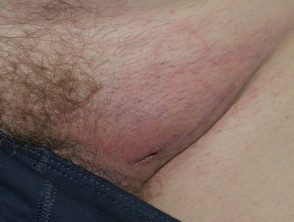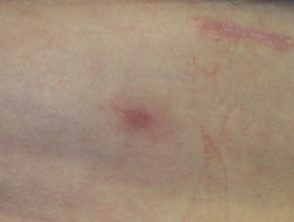Introduction
The introduction of directed Cancer therapies and immunotherapy has revolutionized the management and forecast of metastatic melanoma, significantly improving drug response rates and disease-free survival.
These medications are associated with a variety of adverse effects and cutaneous Toxicities are the most frequently observed.
Melanoma metastasis

Cutaneous

Subcutaneous

Lymphatic
What are targeted therapies?
Targeted therapies (BRAF MEK inhibitors and inhibitors) are medicines to treat BRAFmutant metastatic melanoma. Activating mutations at BRAF gene are present in 50-70% of melanomas. The most common mutation occurs at position 600, where valine (V) is replaced by glutamic acid (E) (V600E) [1].
What is immunotherapy?
Immunotherapy includes anticytotoxic T lymphocyte antigen 4 (CTLA4) antibodies and antibodies to programmed cell death protein 1 (PD1). These medications are used to treat metastatic melanoma, renal cell carcinoma, non-small cell lung cancer, head and neck scaly cell carcinoma and others.
How do these drugs work?
Targeted therapies
Mutations in BRAF the gene leads to an overactivation of the mitogen-activated protein kinase (MAPK), which plays a key role as a regulator of cell growth, differentiationand survival. Inhibition of the BRAF kinase and mitogen-activated extracellular signal regulated kinase (MEK) leads to inhibition of cellular proliferation.
The mechanism behind most skin toxicities associated with BRAF Inhibitors are believed to be a paradoxical activation of mitogen-activated kinase (MAPK) in cells without BRAF mutation, which leads to cellular hyperproliferation [2].
Immunotherapy
CTLA4 and PD1 are downregulating immune checkpoint receptors T cell immune function and promote self tolerance.
- Inhibition of these targets induces activation of the immune system and anti-tumor cytotoxic activity T cells.
- Induction of a breach of tolerance against the tumor may be responsible for the development of immunodeficiencies adverse events [3].
What are the cutaneous adverse effects of targeted therapies?
BRAF inhibitors
BRAF Inhibitors include vemurafenib and dabrafenib. Skin side effects are common.
Hyperkeratotic keratinocytic injuries
Squamous cell carcinoma of the skin (SCC) occurs frequently in patients treated with BRAF inhibitor as a single agent. the incidence decreases with the addition of a MEK inhibitor. Most SCCs develop during the first 3 months of therapy, in places damaged by the sun and not damaged by the sun. Most SCCs are finedifferentiated or they are of the keratoacanthoma type. Excision It is the standard treatment with a high cure rate. Oral acitretin can be used as a preventive agent, as it reduces epidermal proliferation and does not interfere with the action of the targeted therapy.
Wart keratosis presents as a hyperkeratotic papule resembling a viral wart or small keratoacanthoma. They are considered premalignant and therefore cutaneous SCC precursors and should be controlled. Treatment options include cryotherapy or surgery. Acitretin can be used as preventive therapy.
Transient acantholytic skin disease
Transient acantholytic dermatosis (Grover's disease) is a common skin disease eruption associate with BRAF inhibitors It occurs in the trunk as rapid onset, itching papules with a crusted top Treatment includes current corticosteroids keratolytic long-term agents (such as urea and salicylic acid) and acitretin control.
Palmoplantar keratoderma
Palmoplantar keratoderma presents as hyperkeratotic plates or calluses on areas of pressure or friction (mainly on the feet). Blisters are rare. Keratoderma can be very painful and limit the patient's daily activities. Treatment with keratolytic agents (such as urea or salicylic acid) and potent topical corticosteroids are indicated (eg, Clobetasol propionate ointment) Patients should be educated to avoid friction and to wear wide and comfortable shoes.
Adverse effects of targeted therapy

Vemurafenib folliculitis

Papilloma due to vemurafenib

Keratoderma due to vemurafenib
Melanocytic injuries
Changes in melanocytic lesions have been reported in patients in BRAF inhibitors, including the development of new naevi and regression or hyperpigmentation of existing naevi. A higher frequency of new primary Melanoma has also been reported. These new melanomas have been shown to be wild-type for the BRAF mutation, suggesting that paradoxical activation of the MAPK pathway may play a role [4].
Pruritus
Drug-induced pruritus is commonly reported in patients taking BRAF Inhibitors Pruritus may be secondary to drug-induced dry skin or transient acantholytic dermatosis. General measures such as the use of soap-free cleaners and emollients Topical corticosteroids can be used if dermatitis arises
Photosensitivity
Drug-induced photosensitivity is observed more frequently with vemurafenib than with dabrafenib and is induced by exposure to ultraviolet (UV) A radiation. Sun protection is recommended, including the use of broad spectrum high protection factor sunscreen.
Other
- Hair follicle changes include diffuse drug induced alopecia, curly or gray hair and pillar keratosis.
- Panniculitis, including erythema knotty
-
Severe cutaneous Adverse reactions (SCAR), including medicine hypersensitivity syndrome and toxic epidermal necrolysis
Adverse effects of targeted therapy

Vemurafenib alopecia

Vemurafenib panniculitis

Drug hypersensitivity syndrome caused by vemurafenib
MEK inhibitors
MEK inhibitors include trametinib and cobimetinib. These medications are generally administered in combination with BRAF inhibitors
Acneiform rashes
Acneiform drug eruptions are the most common cutaneous adverse events associated with monotherapy with MEK inhibitors, appearing in a seborrheic distribution (face, scalp, upper chest and back). Papules and pustules are present but comedones they are absent, unlike acne vulgaris. Oral tetracyclines (doxycycline, minocycline) and isotretinoin are used to prevent and treat acneiform eruptions.
Others
Drug induced itching; Topical corticosteroids can be used for symptomatic treatment.
Combination therapy
As melanoma began to develop resistance to the single agent BRAF Inhibitors, MEK inhibitors were introduced as a combination therapy (dabrafenib + trametinib, vemurafenib + cobimetinib). Adding a MEK inhibitor to a BRAF The inhibitor improves blocking of the mitogen-activated protein kinase (MAPK) pathway.
The combination increases response rates and shows improvement toxicity profile compared to monotherapy. There is a marked reduction in squamous proliferative lesions (cutaneous SCC, verrucal keratosis, acantholytic dermatosis, palmoplantar keratoderma), hair follicle changes, and acneiform eruptions. [4.5].
Folliculitis
Folliculitis is the most common adverse effect of BRAF Combined MEK inhibitor and inhibitor therapy and is generally mild. An antiseptic wash is usually sufficient to treat it [4].
What are the cutaneous adverse effects of immunotherapy?
Anti-CTLA4 antibody
The anti-CTLA4 antibody is ipilimumab.
Maculopapular exanthema
Ipilimumab commonly causes a maculopapular rash or morbilliform drug rash. It is usually mild to moderate in severity and appears on the trunk and extremities. Mild cases can be managed without interruption or dose reduction of ipilimumab. Topical corticosteroids or topical calcineurin inhibitors can be used. In more severe cases, ipilimumab should be discontinued and oral prednisone may be indicated.
Vitiligo type depigmentation
Vitiligo-like depigmentation has been reported with ipilimumab. Patients must be educated about sun protection. An association between the development of vitiligo and a better prognosis of the disease has been reported in multiple studies. [5].
Others
Other cutaneous adverse effects of immunotherapy may include:
-
Pruritus: itching induced by ipilimumab without skin lesions or xerosis
- Neutrophils skin disease – pyoderma gangrenous type ulceration and acute neutrophilic dermatosis
- Psoriasiform rashes de novo psoriasiform eruptions or exacerbation of pre-existing psoriasis
-
Serious cutaneous adverse reactions (SCAR): drug hypersensitivity syndrome and Stevens-Johnson syndrome, toxic epidermal necrolysis.
Anti-PD1 antibodies
Anti-PD1 antibodies include nivolumab and pembrolizumab.
They are better tolerated than anti-CTLA4 antibodies. However, anti-PD1 antibodies show similar adverse reactions related to the immune system. [4.6]. The types of reactions can include:
- Drug-induced morbilliform rash.
- Vitiligo
- Pruritus
- Lichenoid drug rash: patients with anti-PD1 antibodies can develop violaceous pruritus papules and plaques that resemble lichen planus, distributed over the body with minimal mucous membrane participation, although their appearance is often delayed up to several months; Mild to moderate reactions can be managed with medium to high potency topical corticosteroids, while severe cases may require oral prednisone.
-
Blisters bullous pemphigoid and lichenoid bullous reaction; the start can be delayed up to several months.
- Psoriasiform eruption
-
Serious cutaneous adverse reactions (SCAR): drug hypersensitivity syndrome and Stevens-Johnson syndrome, toxic epidermal necrolysis.
Adverse reactions to immunotherapy.

Pembrolizumab-induced eczema

Pembrolizumab-induced psoriasis

Pembrolizumab-induced bullous pemphigoid

Nivolumab-induced lichenoid dermatitis

Nivolumab-induced lichenoid dermatitis

Oral lichen planus due to nivolumab
Combination therapy
The combination of antiCTLA4 and sample of anti-PD1 antibodies higher effectiveness compared to monotherapy, but is also associated with an increase in adverse events [7]. The most common is drug-induced itching. Others include morbilliform rash and lichenoid drug rash. Adverse reactions severe skin as acute generalized exanthematous pustulosis (AGEP) have been reported.
